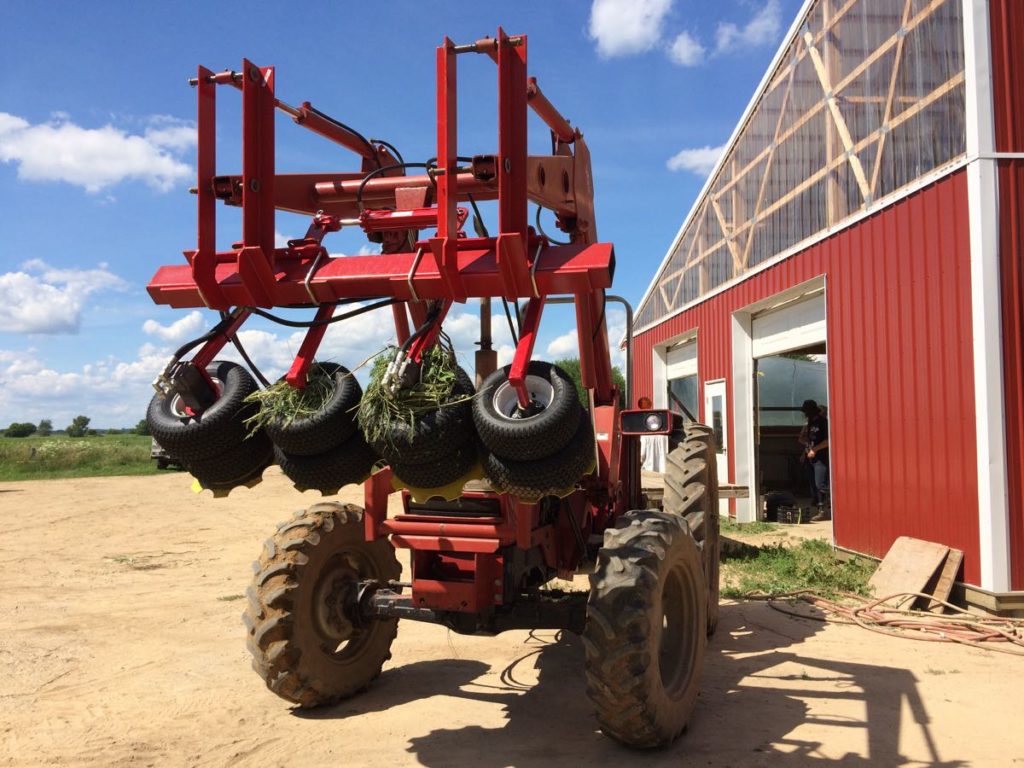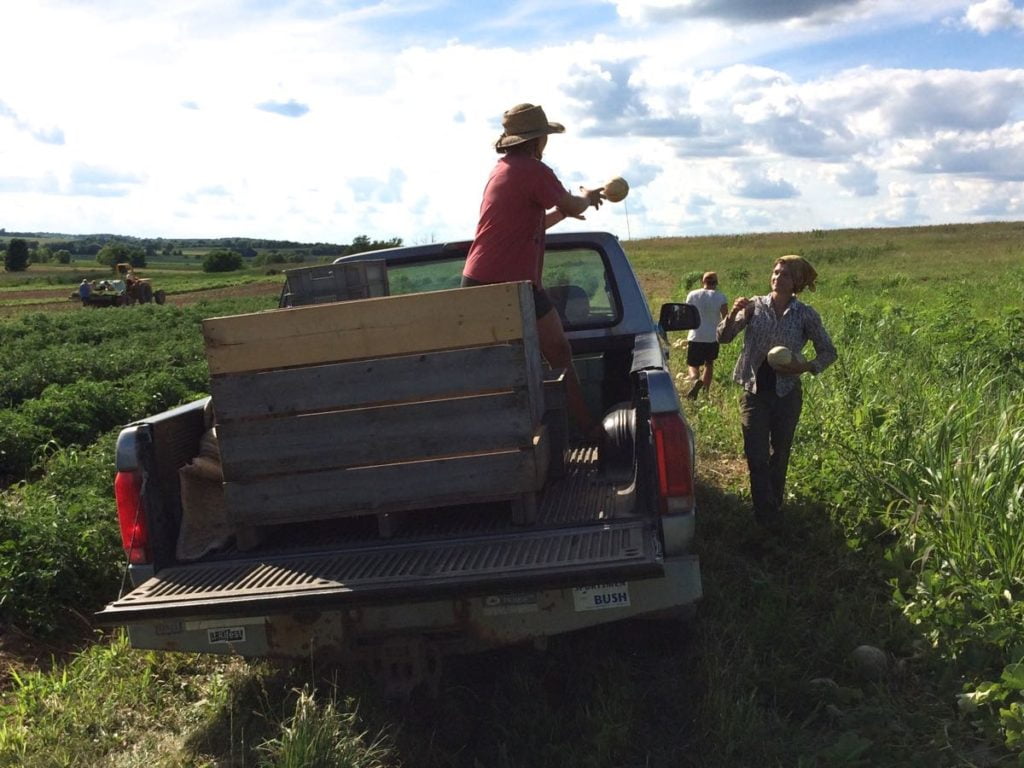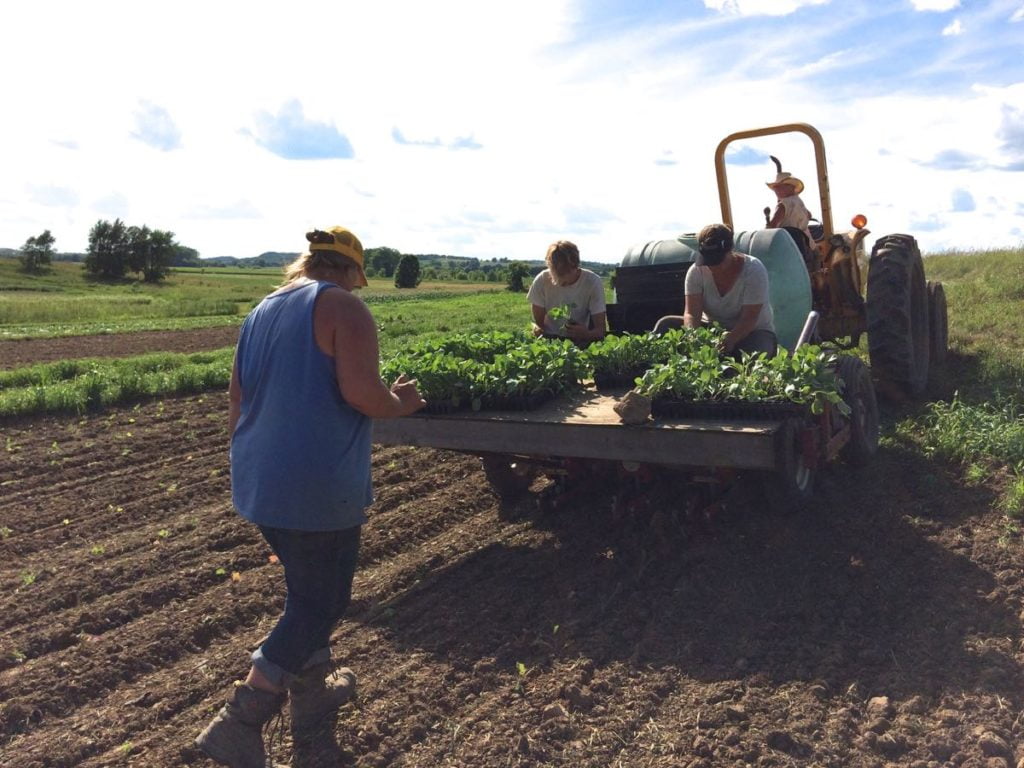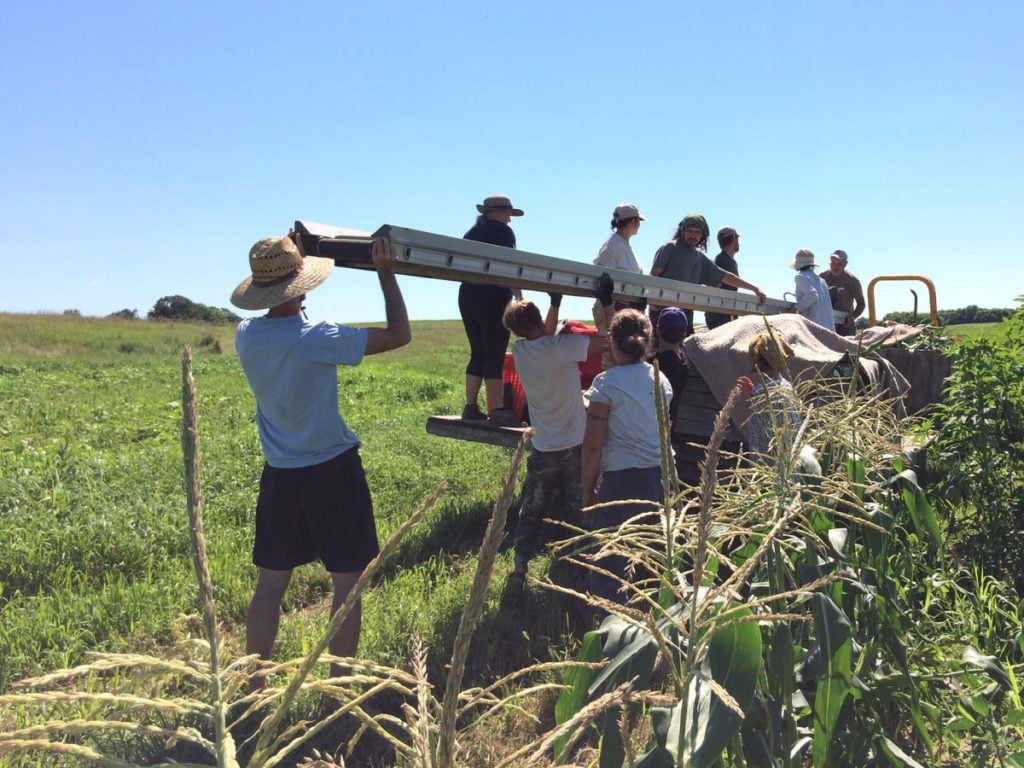Week #9, July 19/20, 2018
- On: July 18, 2018
 0
0
Another new weeding tool

Steve just bought a “weed puller” in hopes of dealing with overgrown weeds. The wet weather from mid-May to early July got in the way of cultivating and hoeing. The window to deal with some of these weeds is dwindling. Here’s how the weed puller is supposed to work. Each pair of rubber wheels rotates inward as you drive down the row, grabbing weed tops and yanking them out of the ground. Some crops will get pulled too but that’s life. At least, that’s the theory. So far, we’ve had middling results. Sometimes it pulls the weeds, sometimes it tears them. New implements always have a learning curve. Steve will fine-tune its use before handing it over to Raul or Roger to use.
We would not have bought this tool in a normal year. It’s expensive and a little odd. If it works in a wet year like this, it will pay for itself with saved crops so it’s worth the risk. There was a time when I used to approve equipment decisions. (Steve and I each have right of veto in purchases and big decisions.) I abandoned my right of veto over equipment purchases years ago because the successes pay for themselves quickly. Steve has good instincts with machinery. Beth
This week

Ellen (right) tosses muskmelons to Mari, who keeps count while stacking them in the bin. Ben works up ahead. Steve and Billy are teaching Ellen how to harvest muskmelons, a coveted job. It’s a fast-moving harvest, the melons smell incredibly good and it’s a useful skill. Of course, other people help; melons are heavy. Muskmelon harvest is less exacting than watermelon harvest (Steve’s job), allowing our crew to take care of it once trained.
Earlier this week, Steve projected that we would have enough melons for one CSA site, maybe two. I fretted about what to put in the CSA boxes that didn’t get melons. So much wasted energy! The crew departed for melon harvest with a few crates, then returned for a wooden bin and more crates. By the time they were done, they filled the bin, all the crates and bed of the pickup truck. That was a surprise but good news. We have enough muskmelons for everyone.
See the tractor and crew in the distance to the left? …

That’s a transplant crew (from left, Maggie, Michio, Kristen and Simone). We’re using this rare dry week to catch up with transplanting. The wet weather has limited our field work to harvests and some crude weeding by hand. When I called Steve last week, he was excited because “it hasn’t rained in six days!” More rain is coming on Friday but we should be caught up on transplanting by then.

We need a big crew for sweet corn harvest. Above, it takes everyone to position the conveyor belt on the wagon after harvest is done. (During harvest, it extends from the wagon over the corn, putting it within easy reach of everyone picking corn.)
At left is Jon Fagan, who worked for us for five seasons before moving on. He’s returned to work for us for a month. I didn’t tell anyone that Jon was returning. It was a great surprise when he showed up at morning meeting today. Working side-by-side is a good way to forge friendships, and Jon has many friends among the crew. We’re glad he’s back, even if only for a short time.
Veggie List & Veggie Notes
Week #9, July 19/20, 2018
– weekly members
– green EOW
Sweet corn, ~10 ears
Muskmelon, 1
Green beans, ~1.7 lb
Cucumbers, 5
Cherry tomatoes, 1 pint
Slicing or plum tomatoes, ~3 ct
Walla Walla onion, 1 or 2
Salanova lettuce, 1 small
Zucchini &/or summer squash, up to 2 lb
You might get a little broccoli.
Next week’s box will probably contain sweet corn, melon, cucumbers, tomatoes, onion and more.
Sweet corn – Now it’s summer! Some ears have bugs at the tip. If you are squeamish, I suggest cutting off the tips before shucking the corn.
Storage. Sweet corn is best when fresh, so we encourage you to eat it asap. Store in the refrigerator, in the husks if you have the room.
Cooking. It is quicker to steam sweet corn than to boil it.
1.) Stand ears of corn upright in a tall pot. Put one inch of water in the pot.
2.) Bring the water to a boil. If the corn is cold when you begin cooking, steam for 5 – 6 minutes. If the corn starts at room temperature, steam for 4 – 5 minutes. The cooking time will vary somewhat depending on how many ears are in the pot. Pay attention to how the corn smells. The scent changes once the corn is ready. Another clue: water will bead on the corn until it is cooked. Don’t overcook it.
Muskmelon – These are ripe and ready to eat. Keep at room temperature but refrigerate if not eaten within 2 – 3 days.
Green beans – Keep in bag and store in the warmer part of your fridge.
Salanova lettuce – These are tiny heads! We harvest young in summer so the lettuce doesn’t get bitter. Remember, Salanova is the lettuce variety that you can cut across the base and it falls apart into salad mix. Wash well.
RECIPES
Visit our 2018 Recipe Log or our 2017 Recipe Log or join our Facebook discussion group.
LOCAL THYME/ Comforting Classics
Caprese Skewers
Swedish Cucumber Salad
Fresh Tomato Pesto Pasta Salad with Green Beans and Corn</a>
LOCAL THYME/ Outside the Box Recipes
Orzo with Smoky Tomato Vinaigrette
Blackened Catfish with Cucumber Raita
Green Beans with Smoked Almonds
LOCAL THYME/ Quick and Easy Meal
Orzo Salad with Grilled Summer Vegetables
Recipes from Lauren
CORN & ZUCCHINI SALAD WITH FRESH CHEVRE
Adapted from Bon Appetit
Sweet corn, Walla Wallas, zucchini and goat cheese are literally a match made in heaven. You could eat this combo about any which way, but I love it as a salad. It is absolutely dreamy with crunch from the corn, meatiness from the squash, creaminess from the rich fresh chevre and sweetness from just about everything. But, if you aren’t feeling salad, feel free to skip the oil and vinegar and throw this together with a dozen eggs for a quick frittata.
Also, don’t let the chevre confuse you. Chevre is just another name for fresh goat cheese– it has a little more funk than the stuff labeled goat cheese at the store. If you can’t find it, plain old goat cheese or feta with both work just fine. Lauren
Serves 4-6 as a side (2 as a main)
Takes 15 minutes
4 ears of corn, husked
2 teaspoons Kosher salt, divided
1-1/2 pounds zucchini or summer squash, thinly sliced
1/2 Walla Walla onion, thinly sliced
4 ounces fresh chevre (if you can find it–feta if you can’t), crumbled
1 tablespoon olive oil
1 teaspoon champagne vinegar (rice vinegar, white wine vinegar or white vinegar would all also work if you don’t have champagne)
1/2 teaspoon red pepper flakes
- In a large pot, season water with 1 teaspoon salt and bring to a boil. Once boiling, add corn and cook for 7 minutes. Drain and rinse with cold water until cool to the touch. Remove to a cutting board and cut kernels off cob.
- Add corn, zucchini, Walla Walla and chevre to a large bowl. Stir together until well mixed (the zucchini can stick together causing this to take a bit of stirring). Drizzle with oil and vinegar. Add remaining salt and red pepper flakes. Stir to combine once more. Taste and adjust seasonings to taste.
.
.
SUMMER LOVE SALAD
Takes 20 minutes
Serves 4-6 as a side (or 2 as a meal)
1 head Salanova lettuce
1 teaspoon Kosher salt
1 pound green beans, ends trimmed, and cut into 1-inch pieces
2 cucumbers
1 pint cherry tomatoes, halved
Dressing:
1/4 olive oil
2 tablespoons cider vinegar
1 teaspoon maple syrup
1 teaspoon Kosher salt
1/4 teaspoon freshly ground black pepper
1 cup walnuts, finely chopped
- Cut base of salanova so that the head of lettuce falls into leaves. Rinse well and put in a colander to dry while you prepare the rest of your salad.
- Fill a stock pot half full of water. Add 1 teaspoon salt and bring to a boil. Once boiling, add beans. Cook for 5 minutes then drain immediately. Rinse with cold water until cool to the touch. Place drained, cooled beans in large bowl with halved cherry tomatoes.
- Cut cucumbers in half. Scrape the seeds out with a spoon. Slice and add to bowl with beans and tomatoes.
- Prepare you dressing by whisking together olive oil, vinegar, maple syrup, salt and pepper in a small bowl until emulsified. The mixture will get cloudy when the oil and vinegar come together (this is emulsification). Add the walnuts and stir them in gently with a spatula. Pour dressing over the veggies.
- When ready to serve, add salanova lettuce to the mix. If you don’t plan to eat this all at once, just add the amount of lettuce to the amount of veggies you plan to eat. The greens don’t store well when mixed with the dressing.
.



